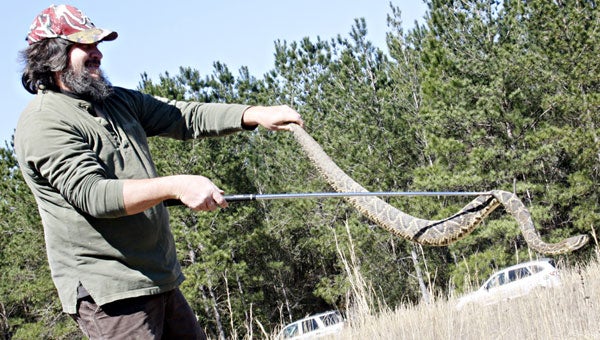RATTLER HUNTIN’
Published 12:00 am Tuesday, March 5, 2013
Rattlesnake Republic has nothing on Opp’s Don Childre, Chuck Brooks and Christopher Harper when it comes to catching Eastern diamondbacks for the Opp Rattlesnake Rodeo.
The trio, along with Opp Councilman T.D. Morgan and his son Tracey, set off early Monday morning in Geneva County looking for the rodeo’s star attraction.
Among the trio, there are decades and decades of experience catching the largest rattlesnake in America, and they have it down to a science.
Monday’s cold weather was prime snake hunting time.
“Snakes are more docile when it’s in the upper 20s and lower 30s,” Brooks said. “When it warms up, they have a drastic change in reaction time. We hate rodeos when it’s 70 degrees outside. The snakes are much more aggressive; it’s like they are on steroids.”
Specialized, sturdy tubing along with a dulled treble hook serves as means to catch the snakes, and to listen down into the depths of gopher and gopher tortoise burrows.
“If the tubing hits the snake it rattles,” said Harper.
Snake hunting consists of walking the terraces along a hayfield near a wooded pine area and near sandy areas, where the burrows are found.
Monday, there were around 15 burrows which were checked for snakes, and they didn’t find one. They’ll check again in a few days.
“Snakes get in the very back of the hole,” Brooks said. “Sometimes, we hit the gopher turtle shell, but the snake is behind it. We leave them alone. I’ll check these again in a few days.”
The trio instinctively smells rattlesnakes.
“The snakes have a musky smell mechanism like a skunk,” Brooks said.
When they finally find one, they drag it out like a farmer uses a hayfork to drag hay.
The trio, along with a few more, is what’s left of 30 to 40 snake hunters since the 1970s, Childre said.
“We have a handful of hunters right now,” he said. “That’s part of the reason we don’t get as many snakes as we used to.”
In the early days of the rodeo, hunters would easily collect 300 snakes, which were used for the shows. Some were skinned and the meat was sold at the rodeo.
Childre said now the rodeo purchases USDA approved snake meat to sell at the event, and they try to collect around 40 snakes each year.
“The first year the city hosted the rodeo, I said I didn’t want but 25 snakes,” Childre said. “But people wanted to see more, so we started collecting around 40 or so.”
Another factor that plays into snake hunting is less land.
“We have about 80 percent less land than we did in the 70s,” Brooks said.
Some 63,000 acres south of Opp hunters used to hunt has been leased, and is now behind closed gates, the trio said.
“The best way to tell what the population of snakes are in a particular area is to ride a busy highway after the Fourth of July or another major holiday,” Brooks said. “Ask the mail carriers and the troopers, they can tell you.”
As of Monday, they’ve only caught one.
This year’s Rodeo is set for March 22-23, at Channell-Lee Stadium. Entertainment headliners are Little Texas on Friday and Steel Magnolia on Saturday.
Tickets are on sale now at City Hall or www.rattlesnakerodeo.com.




